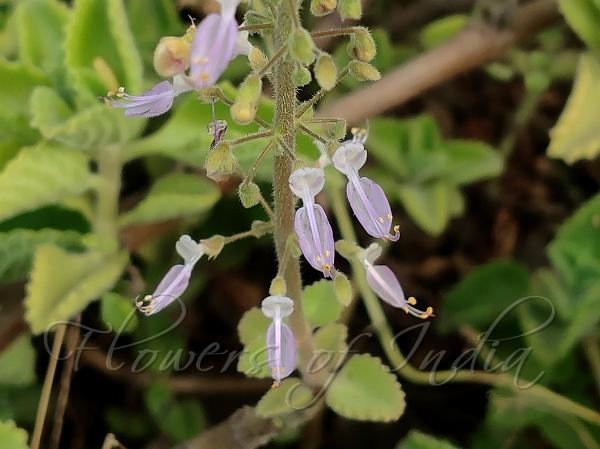|
| Cuban Oregano |
|

|

| File size | 538968 |
| Original date | 4/18/22 7:16 AM |
| Resolution | 4608 x 3456 |
| Flash | Flash did not fire |
| Focal length | 4.05mm |
| Exposure time | 1/100s |
| Aperture | 1.78 |
| Focus Distance | |
| Metering Mode | $meteringMode |
| Camera make | Lenovo |
| Camera model | Lenovo L38111 |
| Sensor type |
|
|
|
|
Photo: |
Botanical name: Coleus amboinicus Family: Lamiaceae (Mint family)
Synonyms: Plectranthus amboinicus, Coleus aromaticus, Plectranthus aromaticus
Synonyms: Plectranthus amboinicus, Coleus aromaticus, Plectranthus aromaticus
Cuban Oregano is a sprawling and somewhat succulent herb, growing to 1 m
tall. The plant is sometimes prostrate at base, with the branchlets rising
up, densely hairy. Leaves have stalks 1-4.5 cm long, densely velvety, like
most mint family plants. Leaf blade is fleshy, broadly ovate to circular,
rhombic, or kidney-shaped, 4-10 cm long, 3-9 cm broad, coarsely toothed at
margin or entire toward base. Flowers are borne in 10-20-flowered, densely
velvety spikes, 10-20 cm long. Flower stalks are slender, up to 5 mm long.
Sepal cup is bell-shaped, 1.5-4 mm long. Flowers are pale blue or mauve to
pink, 8-12 mm long - the upper lip is up to 4.5 x 3 mm, erect, the lower
lip up to 5-6 x 4 mm, concave. Filaments of stamens are mostly fused into
a tube around style. The origin of Cuban Oregano is unknown - it is widely
cultivated world-wide. The leaves are strongly flavoured and make an
excellent addition to stuffings for meat and poultry. Finely chopped, they
can also be used to flavour meat dishes, especially beef, lamb and game.
Medicinal uses: The leaves have also had many traditional
medicinal uses, especially for the treatment of coughs, sore throats
and nasal congestion, but also for a range of other problems such
as infections, rheumatism and flatulence. In Indonesia Cuban Oregano
is a traditional food used in soup to stimulate lactation
for the month or so following childbirth.
The leaves have also had many traditional
medicinal uses, especially for the treatment of coughs, sore throats
and nasal congestion, but also for a range of other problems such
as infections, rheumatism and flatulence. In Indonesia Cuban Oregano
is a traditional food used in soup to stimulate lactation
for the month or so following childbirth.
Medicinal uses:
 The leaves have also had many traditional
medicinal uses, especially for the treatment of coughs, sore throats
and nasal congestion, but also for a range of other problems such
as infections, rheumatism and flatulence. In Indonesia Cuban Oregano
is a traditional food used in soup to stimulate lactation
for the month or so following childbirth.
The leaves have also had many traditional
medicinal uses, especially for the treatment of coughs, sore throats
and nasal congestion, but also for a range of other problems such
as infections, rheumatism and flatulence. In Indonesia Cuban Oregano
is a traditional food used in soup to stimulate lactation
for the month or so following childbirth.| Identification credit: Narendra Joshi | Photographed at Bijnor, UP & Satara, Maharashtra. |
• Is this flower misidentified? If yes,